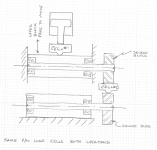ndzied1
Lifetime Supporting Member
I have a customer that is trying to calibrate a load cell in a system by putting another load cell into that system and seeing if they agree. Each load cell is independent from the other.
The picture shows the basic mechanical layout of what they are doing.
My theory is that if I assume that the mechanics are perfect (no friction and perfect alignment of components, no deflection of components, etc.), that if they are reading 1000 LBF on each of the transducers, that the cylinder is pressing with 2000 LBF force. They are thinking that the same force goes through both transducers so that the cylinder is only pressing with 1000 LBF force.
I have asked them to take pressure readings at the cylinder to confirm or disprove my theory but in the meantime, wanted to get some feedback from others.
This came about because the two reading agree up to a point and then diverge. My thought is that with the force doubling that the system is running out of pressure or starting to deflect. They don't want to believe me.
Thanks.

The picture shows the basic mechanical layout of what they are doing.
My theory is that if I assume that the mechanics are perfect (no friction and perfect alignment of components, no deflection of components, etc.), that if they are reading 1000 LBF on each of the transducers, that the cylinder is pressing with 2000 LBF force. They are thinking that the same force goes through both transducers so that the cylinder is only pressing with 1000 LBF force.
I have asked them to take pressure readings at the cylinder to confirm or disprove my theory but in the meantime, wanted to get some feedback from others.
This came about because the two reading agree up to a point and then diverge. My thought is that with the force doubling that the system is running out of pressure or starting to deflect. They don't want to believe me.
Thanks.



